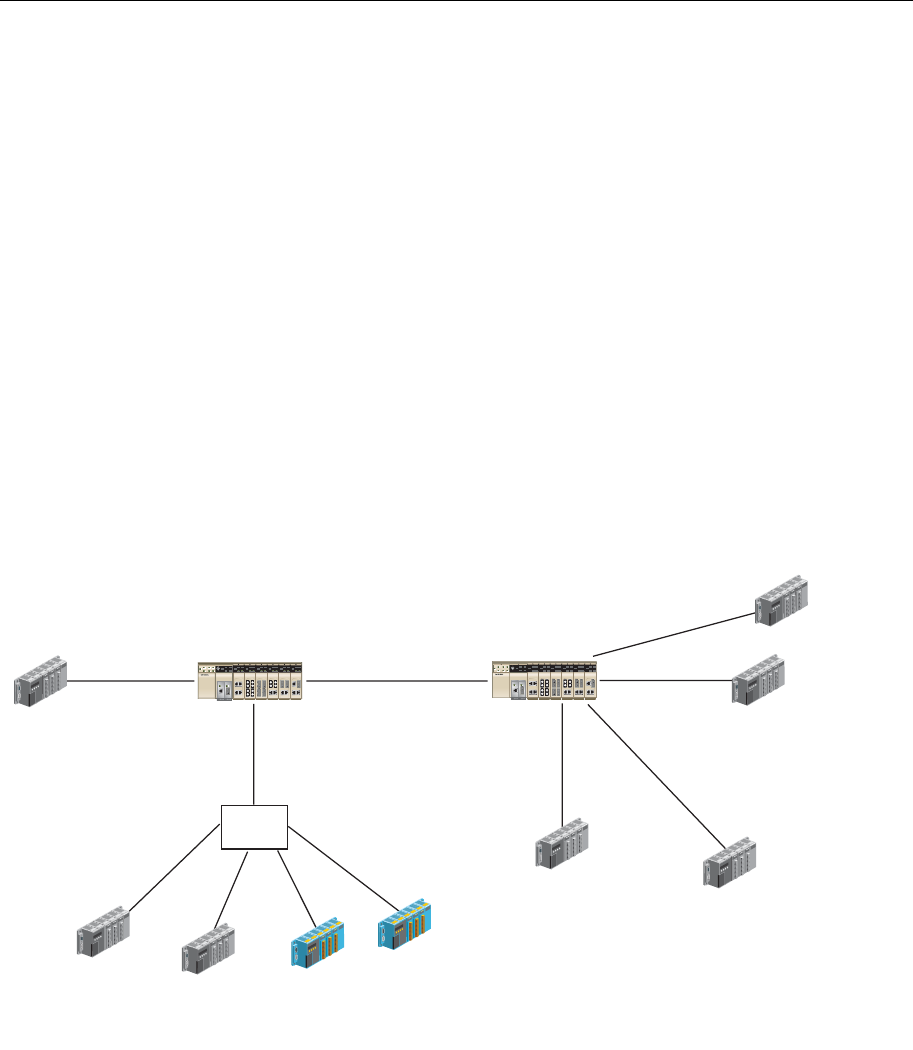
EDS-726 Series User’s Manual Featured Functions
3-39
The IEEE Std 802.1Q-1998 defines how VLANs operate within an open packet-switched network.
An 802.1Q compliant packet carries additional information that allows a switch to determine
which VLAN the port belongs to. If a frame is carrying the additional information, it is known as a
tagged frame.
To carry multiple VLANs across a single physical (backbone, trunk) link, each packet must be
tagged with a VLAN identifier so that the switches can identify which packets belong in which
VLAN. To communicate between VLANs, a router must be used.
MOXA EDS-726 supports two types of VLAN port settings:
y Access Port: The port connects to a single device that is not tagged. The user must define the
default port PVID that assigns which VLAN the device belongs to. Once the ingress packet of
this Access Port egresses to another Trunk Port (the port needs all packets to carry tag
information), EDS-726 will insert this PVID into this packet to help the next 802.1Q VLAN
switch recognize it.
y Trunk Port: The port connects to a LAN that consists of untagged devices/tagged devices
and/or switches and hubs. In general, the traffic of the Trunk Port must have a Tag. Users can
also assign PVID to a Trunk Port. The untagged packet on the Trunk Port will be assigned the
port default PVID as its VID.
The following section illustrates how to use these ports to set up different applications.
Sample Applications of VLANs using MOXA EDS-726
Port 3 (Trunk Port, PVID 1)
VLAN 5 Untagged Device
VLAN 3 Untagged
Device
VLAN 4 Untagged
Device
VLAN 5 Untagged Device
VLAN 2 Untagged
Device
VLAN 4 Tagged Device, VID 4
VLAN 3 Tagged Device, VID 3
VLAN 2 Untagged
Device
VLAN 2 Untagged
Device
Device A
Switch A Switch B
Device C
Device B
Device D
Device E
Device F
Device G
Device H
Device I
Port 1 (Access Port
PVID 5)
Port 7 (Access Port
PVID 4)
Port 5 (Access Port
PVID 3)
Port 4 (Access
Port PVID 2)
Port 2 (Trunk Port PVID 2,
Fixed VLAN (Tagged)=3,4)
Port 6 (Access Port PVID 5)
HUB
EDS-726
EtherDevice Switch
34
IM-4TX
12
PWR
P3
P1
P4
P2
IM-4MST
TX
RX
34
TX
RX
1 2
PWR
P3
P1
P4
P2
IM-4MSC
TX
RX
3 4
TX
RX
1 2
PWR
P3
P1
P4
P2
IM-2MST/2TX
TX
RX
34
12
PWR
P3
P1
P4
P2
IM-2MSC/2TX
TX
RX
34
12
PWR
P3
P1
P4
P2
IM-1LSC/3TX
4
12
3
TX
RX
PWR
P3
P1
P4
P2
COUPLER CF
STAT
PWR1 FAULT
MASTER
PWR2
IM-1GSXSCIM-1GTX
MODE
RING
PORT
COUPLER
PORT
FDX/HDX
LNK/ACT
SPEED
EDS-726
EtherDevice Switch
34
IM-4TX
12
PWR
P3
P1
P4
P2
IM-4MST
TX
RX
34
TX
RX
1 2
PWR
P3
P1
P4
P2
IM-4MSC
TX
RX
3 4
TX
RX
1 2
PWR
P3
P1
P4
P2
IM-2MST/2TX
TX
RX
34
12
PWR
P3
P1
P4
P2
IM-2MSC/2TX
TX
RX
34
12
PWR
P3
P1
P4
P2
IM-1LSC/3TX
4
12
3
TX
RX
PWR
P3
P1
P4
P2
COUPLER CF
STAT
PWR1 FAULT
MASTER
PWR2
IM-1GSXSCIM-1GTX
MODE
RING
PORT
COUPLER
PORT
FDX/HDX
LNK/ACT
SPEED
In this application,
y Port 1 connects a single untagged device and assigns it to VLAN 5; it should be configured as
“Access Port” with PVID 5.
y Port 2 connects a LAN with two untagged devices belonging to VLAN 2. One tagged device
with VID 3 and one tagged device with VID 4. It should be configured as “Trunk Port” with
PVID 2 for untagged device and Fixed VLAN (Tagged) with 3 and 4 for tagged device. Since
each port can only have one unique PVID, all untagged devices on the same port can only
belong to the same VLAN.


















